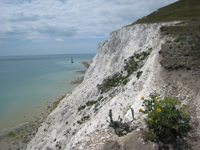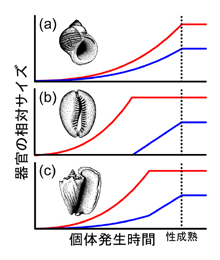Takahiro IRIE, Ph.D
Japan Fisheries Research |
CONTENTS: |
Research Interests:
My study aims to quantitatively understand the genetic/environmental basis of intraspecific variations in life history traits of marine organisms, from the viewpoint of evolutionary ecology. In particular, I'm interested in how the classical Darwinian scheme of evolution (consisting of mutation, natural selection, and heredity) successfully explain the phenotypic patterns shown by actually existing organisms in the field; essentially this is a quantitative question. My approach is threefold: working hypotheses are established to explain the spatial and/or temporal patterns in life-history and morphological traits quantified through (1) field surveys such as quadrat-based and mark-recapture sampling. The hypotheses are tested by (2) conducting laboratory rearing experiments under controlled conditions, which is followed by (3) statistical analyses. In addition to the empirical approach, I occasionally perform a theoretical study based on (4) mathematical modeling, mostly based on fitness maximization or evolutionary invasion analysis. Recently, I got started on using (5) geochemical analysis of biogenic carbonates and (6) supercomputers specialized for analyzing a large amount of genomic data generated by next-generation sequencing. I wish to get into the field of ecology/evolutionary biology that no one has seen before, by combining the advantages of these multiple approaches.
Research Target: Monetarian Cowries

I have focused on intertidal cowries (genus Monetaria) over 20 years as a major research target of phenotypic intraspecific variation, population genomics, and biomineralization. This group is interesting in terms of biogeography because three out of five species are widely distributed across the Indo-Pacific ocean (M. caputserpentis, M. moneta, and M. annulus) and the others are endemic to Easter Isl. (M. caputdraconis) or French Polynesia (M. obvelata). The widely distributed species exhibit remarkable latitudinal clines in shell morphology (e.g., body size and shell thickness), but it is still unclear what proportion of the variation is accounted for by genetic variation.
Larval ecology linking life history theories and biogeography

Currently I am intensively studing veligers larvae of Monetaria annulus. This species hatches out about 80 μm in protoconch diameter, and keeps a planktonic lifestyle at least for two months until reaching >1000 μm in veliconch width. In maine gastropods there is a life history spectrum from the direct development species without dispersal ability to the indirect development species with a long-time planktonic stage, as well as the poecilogonic species with both types of strategy. It is technically impossible to individually trail veligers in the field, because they are too minute and show a wide range of dispersion for a long time in the ocean. This leaves a lot of mysteries around the larval ecology particularly for long-term planktotrophic species. This project aims to establish the framework for estimating a migratory pattern from hatching to settlement by combining laboratory rearing of veligers, geochemical analysis of larval shells, and population genomics based on the next-generation sequencing.
Population Size Estimation From Neutral Genetic Information

In conservation ecology and fishery science, there is a strong need to improve the estimating techniques for wild population sizes of marine organisms. Current estimation methods have problems with both accuracy and precision, because of heavily relying on fishery-derived data, collected non-randomly. A new technique based on the neutral genetic information of randomly sampled individuals across generations is expected to be the next generation alternative. This procedure is referred to as the Close-Kin approach, in which the numbers of parent-offspring pairs (POPs) and half-sibling pairs (HSPs) are assumed to be the metrics of population size. These kinships are quantified by comparing neutral allele frequencies (e.g., those at SNPs) by means of the RAD-sequencing. However, no statistical procedure has been established yet to estimate population size from kinship information. This project aims to establish a hierarchical Bayesian model to compute the posterior distribution of wild population size from the numbers of parental and offspring samples, POPs, and HSPs.
Adaptive Significance of the Temperature-Size Rule

Ectotherms often exhibit smaller adult body size with faster growth when reared at higher temperatures. This phylogenetically widespread trend is called the temperature-size rule (TSR), but exceptionlly some species do not follow the TSR. Currently, I am addressing the following three questions. (1) I proposed a hypothesis that calcifying ectotherms may defy the TSR when getting bigger at cooler environments does not pay off, because calcium carbonate is more soluble at lower temperatures and the calcification cost increases with decreasing temperature. As a result, calcifers may mature at a smaller size with very slow growth at lower temperatures.I tested this possibility by conducting a rearing experiment of intertical cowries in 2013. (2) I am also interested in what proportion of body size variation is explained by the TSR in the focal population(s). This is an important aspect particularly when considering the natural selection on body size in wild populations. (3) Finally, I am trying to specify the mathematical conditions that the TSR is adaptive. This is a long-standing interest of mine, and is important in understanding the mechanism by which the TSR has been evolutionally maintained.
Ecological Study of Calcification

Calcification is one of the characteristics which is unique to marine invertebrates in the sense of being not found in most terrestrial invertebrates (e.g., holometabolous insects). Benthic inverteberates (e.g., molluscs, echinoderms, and cnidarians) and algae (e.g., corallinales) as well as various sizes of planktons are able to build calcareous exoskeletons. A serious concern related to calcification is ocean acidification (OA), in which increasing atmospheric CO2 partial pressure affects the carbonate system of seawater (both aqueous carbon dioxide ion and hydrogen ion concentrations increase and carbonate ion concentration decreases). Acidified seawater is believed to have a deleterious effect on the physiology of calcifying organisms and in this context, a huge number of papers on OA have been published since about 2010. In particular, coccolithophores (calcifying algae) are under intense study because they are one of the most important producers of calcite and hence play a pivotal role in global biogeochemical cycles. The OA paradigm has also promoted the fundamental science for understanding the mechanisms of calcification and other biomineralization. In fact, our knowledge of how marine organisms proceed with calcification has dramatically improved in just the past few, following the technological breakthroughs in both geochemical analysis and DNA sequencing methods. Under these circumstances, I am trying to contribute to the calcification study from the viewpoint of ecology and evolution.
Application of Dynamic Optimization to Life History Theory

The dynamic optimization is a mathematical technique for solving the minimization / maximization problme of an evaluating function in terms of the optimization of time series. This study is based on the Pontryagin's maximum principle, which is a principal tool providing analytical solutions in the optimal control theory. Our model considers an organism with determinate growth, consisting of soft body and external shell. Before sexual maturation, resource is allocated between both conponents for growth at each moment of ontogeny in a given ratio. We consider that natural selection optimize the time series of the allocation ratio by maximizing the lifetime reproductive success of an individual. Entire resource is used for reproduction after sexual maturation. Our model optimize the length of growth stage (i.e., timing of maturation) as well. As a result of analysis, we found that this model can explan well the observed diversity in the growth pattern of molluscs.
Spatial Autocorrelation and Pseudoreplication

Pseudoreplication is an annoyance for empirical ecologists working on benthos. Ecologists often run statitical hypothesis tests on the data obtained from experiments or field surveys. Many models assume the statistical independence in the random term; pseudoreplication arises when this assumption is violated. In practice, it frequently occurs when experimental design is misspecified or when autocorrelation is inherent in (unobservable) environmental variables. I'm providing information on the prevention and considering the post-hoc coping technique of this problem.
Curriculum Vitae:
| Born: 1980 | (Yokohama). Nationality: Japan. |
| 1996-1999: | Keio High School (Yokohama; Japan). |
| 1999-2003: | Kyushu University,
Department of Biology (Fukuoka; Japan). Bachelor of Science. |
| 2003-2005: | Kyushu University,
Dept of Biology, Mathematical Biology Laboratory. Master's Degree in Science. |
| 2005-2008: | Kyushu University,
Dept of Biology, Mathematical Biology Laboratory. Doctoral Course; JSPS Research Fellow (DC1). Ph.D (Science). |
| 2008-2011: | University of the Ryukyus, Tropical Biosphere Research Center (Sesoko Station). JSPS Research Fellow (PD). |
| 2010: | University of Amsterdam,
IBED (from March 2010 through December 2010). |
| 2011-2013: | Stanford University Department of Biology JSPS PD Fellow for Research Abroad |
| 2013-2014: | The University of Tokyo,
AORI Post-doctoral Researcher |
 |
| 2014: | Fisheries Research Agency National Research Institute of Far Seas Fisheries Research Assistant |
| 2014-2024: | The University of Tokyo,
AORI Assistant Professor |
| 2024-2025: | AIST, Marine Geo-Environment Research Group, Technical Staff |
| 2025-: | FRA, Fisheries Resources Institute, Technical Staff |
Refereed Publications:
| 32. 2024, Yumeng Pang, Yusuke Yokoyama, Takahiro Aze, Takahiro Irie, Chih-Shin Chen, Tomohiko Kawamura, and Yoko Iwata. Population connectivity of the swordtip squid Uroteuthis edulis between southern Japan and northern Taiwan using statolith trace elemental analysis. Frontiers in Marine Science 11. |
| 31. 2023, Iki Murase, Tatsuhiko Kawamoto, Norikatsu Akizawa, and Takahiro Irie. Rearing in strontium-enriched water induces vaterite otoliths in the Japanese rice fish, Oryzias latipes. Royal Society Open Science 10(6):230410. |
| 30. 2022, Shota Hosono, Takahiro Irie, Jun Yamamoto, Mitsuhiro Nakaya, Yasunori Sakurai, Tomohiko Kawamura, and Yoko Iwata. Negative temperature dependence of statolith Sr/Ca and its intraspecific variability in experimentally maintained spear squid Heterololigo bleekeri. Journal of the Marine Biological Association UK 102: 315-321. |
| 29. 2021, Azumi Kuroyanagi, Takahiro Irie, Shunichi Kinoshita, Hodaka Kawahata, Atsushi Suzuki, Hiroshi Nishi, Osamu Sasaki, Reishi Takashima, and Kazuhiko Fujita. Decrease in volume and density of foraminiferal shells with progressing ocean acidification. Scientific Reports 11: 19988. |
| 28. 2020, Takahiro Irie and Atsushi Suzuki. High temperature stress does not distort the geochemical thermometers based on biogenic calcium carbonate: Stable oxygen isotope values and Sr/Ca ratios of gastropod shells in response to rearing temperature. Geochimica et Cosmochimica Acta 288: 1-15. |
| 27. 2019, Iki Murase, Tatsuya Kawakami, Takahiro Irie, and Kei'ichiro Iguchi. Counter-directional latitudinal clines of size at upstream migration between two adjacent water bodies in a Japanese amphidromous fish. Marine Ecology Progress Series 624:143-154. |
| 26. 2019, Hiroaki Fukumori, Hajime Itoh, and Takahiro Irie. The mitochondrial genome of the gold-ringed cowry Monetaria annulus (Mollusca: Gastropoda: Cypraeidae) determined by whole-genome sequencing. Mitochondrial DNA Part B: Resources 4:2305-2307. |
| 25. 2019, Javier Montenegro, Koji Mochida, Kumi Matsui, Daniel F. Mokodongan, Bayu K. A. Sumarto, Sjamsu A. Lawelle, Andy B. Nofrianto, Renny K. Hadiaty, Kawilarang W. A. Masengi, Lengxob Yong, Nobuyuki Inomata, Takahiro Irie, Yasuyuki Hashiguchi, Yohey Terai, Jun Kitano, and Kazunori Yamahira. Convergent evolution of body color between sympatric freshwater fishes via different visual sensory evolution. Ecology and Evolution 9:6389-6398. |
| 24. 2019, Kunio Shirakihara, Fumio Nakahara, Masanori Shinohara, Miki Shirakihara, Kazuhiko Hiramatsu, Takahiro Irie. Abundance decline in the narrow-ridged finless porpoise population off the Pacific coast of eastern Japan. Population Ecology 61:325-332. |
| 23. 2018, Kozue Nishida, Masahiro Hayashi, Yuzo Yamamoto, Takahiro Irie, Yusuke Watanabe, Chiho Kishida, Yukihiro Nojiri, Mizuho Sato, Toyoho Ishimura, Atsushi Suzuki. Effects of elevated CO2 on shell 13C and 18O content and growth rates in the clam Scapharca broughtonii. Geochimica et Cosmochimica Acta 235: 246-261. |
| 22. 2018, Takahiro IRIE. Studies of marine gastropods connecting natural history and evolutionary ecology. 1. Intraspecific variation of shell characters and morphological taxonomy. Japansese Journal of Ecology, 68(1): 1-15 [In Japanese]. |
| 21. 2016, Takahiro Irie and Naoko Morimoto. Intraspecific variations in shell calcification across thermal window and within constant temperatures: experimental study on an intertidal gastropod Monetaria annulus. Journal of Experimental Marine Biology and Ecology 483: 130-138. |
| 20. 2015, Kozue Nishida, Atsushi Suzuki, Rryosuke Isono, Masahiro Hayashi, Yusuke Watanabe, Yuzo Yamamoto, Takahiro Irie, Yukihiro Nojiri, Chiharu Mori, Mizuho Sato, Kei Sato, and Takenori Sasaki. Thermal dependency of shell growth, microstructure, and stable isotopes in laboratory-reared Scapharca broughtonii (Mollusca: Bivalvia). Geochemistry, Geophysics, Geosystems 16: 2395-2408. |
| 19. 2015, Shouji Houki, Tomohiko Kawamura, Takahiro Irie, Nam-II Won, and Yoshiro Watanabe. The daily cycle of siphon extension behavior in the Manila clam controlled by endogenous rhythm. Fisheries Science 81: 453-461. |
| 18. 2013, Shun Ohki, Takahiro Irie, Mayuri Inoue, Kotaro Shinmen, Hodaka Kawahata, Takashi Nakamura, Aki Kato, Yukihiro Nojiri, Atsushi Suzuki, Kazuhiko Sakai, and Rovert van Woesik. Calcification responses of symbiotic and aposymbiotic corals to near-future levels of ocean acidification. Biogeosciences 10: 6807-6814. |
| 17. 2013, Takahiro IRIE, Naoko MORIMOTO, and Klaus FISCHER. Higher calcification costs at lower temperatures do not break the temperature-size rule in an intertidal gastropod with determinate growth. Marine Biology 160(10): 2619-2629. |
| 16. 2011, Mana HIKAMI, Hiroyuki USHIE, Takahiro IRIE, Kazuhiko FUJITA, Azumi KUROYANAGI, Kazuhiko SAKAI, Yukihiro NOJIRI, Atsushi SUZUKI, and Hodaka KAWAHATA. Contrasting calcification responses to ocean acidification between two reef foraminifers harboring different algal symbionts. Geophys. Res. Lett. 38: L19601. |
| 15. 2010, Takahiro IRIE, Kazuhiro BESSHO, Helen S. FINDLAY, Piero CALOSI. Increasing costs due to ocean acidification drives phytoplankton to be more heavily calcified: Optimal growth strategy of coccolithophores. PLoS One, 5(10): e13436. |
| 14. 2010, Takahiro IRIE. Adaptive significance of the temperature-size rule. Japansese Journal of Ecology, 60(2): 169-181 [In Japanese]. |
| 13. 2010, Naoko MORIMOTO, Yasuo FURUSHIMA, Masayuki NAGAO, Takahiro IRIE, Akira IGUCHI, Atsushi SUZUKI, and Kazuhiko SAKAI. Water quality variables across Sekisei Reef, a large reef complex in southwestern Japan. Pacific Science, 64(1): 113-123. |
| 12. 2009. Azumi KUROYANAGI, Hodaka KAWAHATA, Atsushi SUZUKI, Kazuhiko FUJITA and Takahiro IRIE. Impacts of ocean acidification on large benthic foraminifers: Results from laboratory experiments. Marine Micropaleontology, 73: 190-195. |
| 11. 2009, Takahiro IRIE and Klaus FISCHER. Ectotherms with a calcareous exoskeleton follow the temperature-size rule - evidence from field survey. Marine Ecology Progress Series, 385: 33-37. |
| 10. 2008, Saki HARII, Naoko YASUDA, Mauricio RODRIGUEZ-LANETTY, Takahiro IRIE, Michio HIDAKA. Onset of symbiosis and distribution patterns of symbiotic dinoflagellates in the larvae of scleractinian corals. Marine Biology, 156: 1203-1212. |
| 9. 2008, Takahiro IRIE and Naoko MORIMOTO. Phenotypic plasticity and sexual dimorphism in size at post-juvenile metamorphosis: Common-garden rearing of an intertidal gastropod with determinate growth. Biological Bulletin, 215(2): 126-134. |
| 8. 2007, Takahiro IRIE and Ben ADAMS. Sexual dimorphism in soft body weight in adult Monetaria annulus (Family Cypraeidae). Veliger, 49(3): 209-211. |
| 7. 2007, Kazunori YAMAHIRA, Maiko KAWAJIRI, Kenichi TAKESHI and Takahiro IRIE. Inter- and intrapopulation variation in thermal reaction norms for growth rate: Evolution of latitudinal compensation in ectotherms with a genetic constraint. Evolution, 61(7): 1577-1589. |
| 6. 2007, Takahiro IRIE. Phenotypic plasticity as a proximate mechanism of geographic variations: Body bize clines in ectotherms. Japansese Journal of Ecology, 57(1): 55-63 [In Japanese]. |
| 5. 2006, Takahiro IRIE. Geographic variation of shell morphology in Cypraea annulus (Gastropoda: Cypraeidae). Journal of Molluscan Studies, 72(1): 31-38. |
| 4. 2005, Takahiro IRIE and Yoh IWASA. Optimal growth pattern of defensive organs: The diversity of shell growth among molluscs. The American Naturalist, 165(2): 238-249. |
| 3. 2003, Takahiro IRIE and Yoh IWASA. Optimal growth model for latitudinal cline of shell morphology in cowries (genus Cypraea). Evolutionary Ecology Research, 5(8): 1133-1149. |
| 2. 1997, Ken-Ichi HOSAKA, Takahiro IRIE and Tomoyuki SUGIMURA. The family Cypraeidae (Caenogastropoda) of Yamaguchi Prefecture, western Japan. The Yuriyagai: J. Malacozool. Ass. Yamaguchi, 5(1):127-183. |
| 1. 1997, Takahiro IRIE. Relationships between geographic variation of shell structure and water temperature in Cypraea caputserpentis (Gastropoda: Cypraeidae). The Yuriyagai: J. Malacozool. Ass. Yamaguchi, 5(1):17-29. |